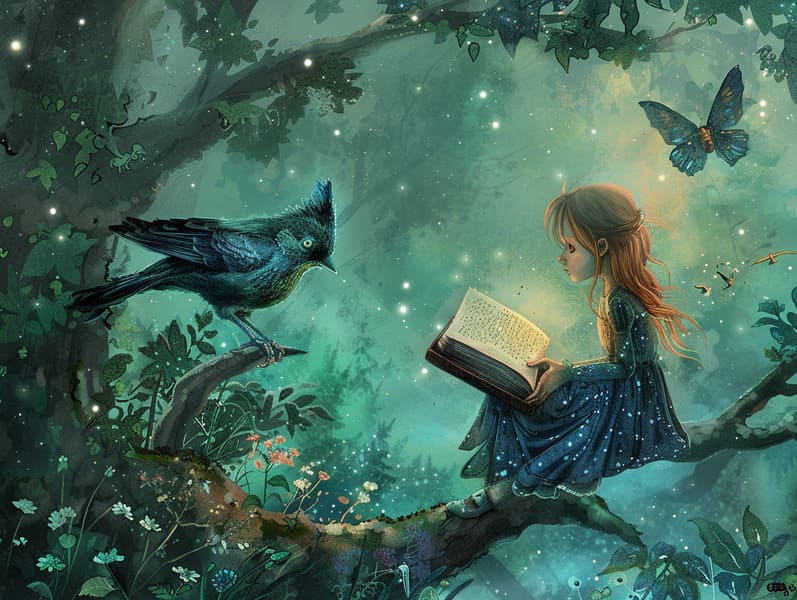
Old fairy tales have historical significance. These narratives have been shared from one generation to the next far before they were ever recorded. They emerged from a variety of societies, including Middle Eastern traditions. They were initially narrated among adults, often carrying themes and messages reflective of the societal norms and beliefs of the time.
The Grimm brothers, Jacob and Wilhelm (the Grimm brothers), were among the first to compile many of these beloved tales. Their volume, "Grimm's Children's Stories," included stories like "Cinderella," "Little Brother and Little Sister," and "The True Story of Snow White," which have since become pillars in the world of children's fairy tales. Similarly, Andersen's imaginative narratives, such as "The Mermaid," and "The Story of the Ugly Duckling," have enchanted hearts worldwide, guaranteeing their place in the pantheon of iconic fairy tales.
Though they are old, these stories remain as applicable as ever, especially as bedtime stories for kids. These magical stories are now available in different formats, including richly illustrated books, enchanting animations, and online fairy tales.
Their lasting presence can be attributed to several enchanting factors:
Moral Lessons: Traditional fairy tales often impart important moral lessons. Fairy tales like "The Shepherd Boy and the Wolf" teach the value of being truthful, while "The Story of the Tortoise and the Hare" exemplify the values of perseverance and meekness. These tales offer little ones clear distinctions between correct and incorrect, guiding their moral compass in a kind yet profound way.
Compassion and Insight: Old fairy tales frequently involve heroes facing difficulties and adversities, stimulating children to relate with their struggles and applaud their triumphs. For instance, "The Story of Beauty and the Beast" emphasizes the value of valuing inner qualities to recognize the inner spirit of a being, cultivating kindness and discernment.
Cultural Insights: Many traditional fairy tales are rich in the cultural contexts from which they were born. Exploring these tales can provide intriguing perspectives into different customs, building a sense of global awareness and knowledge.
Imagination and Creativity: The fantasy-filled elements in traditional fairy tales—enchanted forests—unleash children’s creative dreams. These stories lead readers to supernatural realms, boosting inventive ideas and a sense of mystery that lasts a lifetime.
Timeless fairy tales are not only fantastical but also enlightening. They provide bewitching tools in promoting various mind and heart abilities in young readers. When classic fairy tales are spoken, they promote language development by introducing new vocabulary and complex sentence structures. This practice also nurtures hearing abilities and attention span, as kids stay focused, looking forward to see what happens next.
Furthermore, debating the themes and characters of timeless fairy tales can foster reasoning skills and thinking skills. Children are taught to pinpoint patterns, anticipate outcomes, and know cause and effect. These deliberations also contribute to kids communicate their thoughts and feelings, contributing to their emotional intelligence.
In today’s online age, the proliferation of online storybooks has made these fairy tales more reachable than ever. Internet sites and apps give huge assortments of children's fairy tales that can be enjoyed or listened via anytime, anywhere. Fairy tales told out loud are particularly prevalent, providing an fascinating method for the young to experience these fascinating tales. Spoken stories and spoken videos take characters and settings to life, often paired with mesmerizing musical scores and tunes that augment the story journey.
The unending appeal of classic fairy tales lies in their ability to evolve to present days while retaining their core messages. Contemporary revisions of these stories often include more different figures and modern settings, making them understandable to today’s audience. However, the main ideas of spirit, warmth, and fairness remain unchanged, continuing to strike a chord with children of all ages.
Ancient fairy tales also offer a sense of comfort and understanding. They impart a well-ordered narrative with a obvious beginning, middle, and end, often ending with the solving of conflicts and the triumph of righteousness over wickedness. This dependability can be heartening for children, granting a sense of security in an constantly changing world.
Timeless fairy tales continue to allure and instruct new generations, maintaining their fascination and pertinence in modern society. As kids' bedtime tales, they grant a perfect blend of captivation and insight, promoting moral values, empathy, and creativity. The proliferation of online fairy tales and the sought after status of fairy tales spoken validate that these traditional narratives remain reachable to new generations.
By upholding and making known these narratives, we continue to value the rich tapestry of lore and cultural heritage. Whether you are experiencing a check here beautifully illustrated book, accessing a online collection, or listening through an read-aloud book, the wonder of famous fairy tales is always within reach. These fairy tales reveal of the ageless magic of stories and its ability to tie us across time and space.
Whether you are reading a gorgeously illustrated book, accessing a internet library, or listening to an audio story, the splendor of popular fairy tales is always within reach.
These fairy tales highlight of the unchanging essence of tales and its ability to bond us across epochs and places, casting a charm that charms and informs alike.